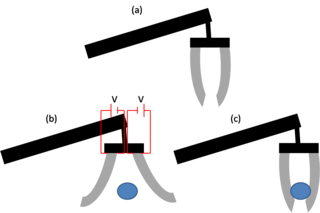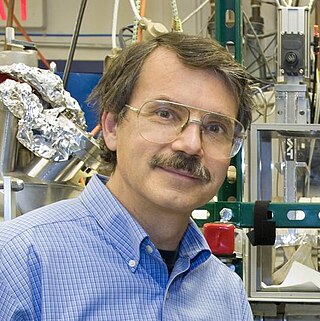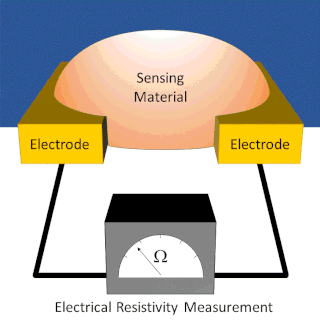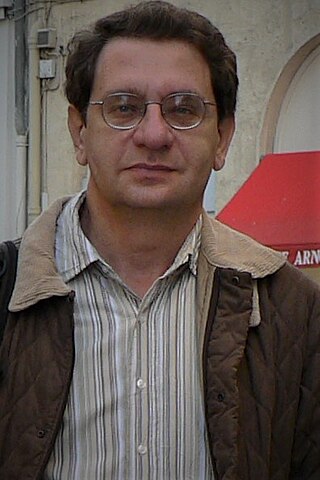Related Research Articles

An electroactive polymer (EAP) is a polymer that exhibits a change in size or shape when stimulated by an electric field. The most common applications of this type of material are in actuators and sensors. A typical characteristic property of an EAP is that they will undergo a large amount of deformation while sustaining large forces.
Liquid crystal polymers (LCPs) are polymers with the property of liquid crystal, usually containing aromatic rings as mesogens. Despite uncrosslinked LCPs, polymeric materials like liquid crystal elastomers (LCEs) and liquid crystal networks (LCNs) can exhibit liquid crystallinity as well. They are both crosslinked LCPs but have different cross link density. They are widely used in the digital display market. In addition, LCPs have unique properties like thermal actuation, anisotropic swelling, and soft elasticity. Therefore, they can be good actuators and sensors. One of the most famous and classical applications for LCPs is Kevlar, a strong but light fiber with wide applications, notably bulletproof vests.

Dielectric elastomers (DEs) are smart material systems that produce large strains. They belong to the group of electroactive polymers (EAP). DE actuators (DEA) transform electric energy into mechanical work. They are lightweight and have a high elastic energy density. They have been investigated since the late 1990s. Many prototype applications exist. Every year, conferences are held in the US and Europe.
David Pines was the founding director of the Institute for Complex Adaptive Matter (ICAM) and the International Institute for Complex Adaptive Matter (I2CAM), distinguished professor of physics, University of California, Davis, research professor of physics and professor emeritus of physics and electrical and computer engineering in the Center for Advanced Study, University of Illinois at Urbana–Champaign (UIUC), and a staff member in the office of the Materials, Physics, and Applications Division at the Los Alamos National Laboratory.

Alex K. Zettl is an American experimental physicist, educator, and inventor.

Dame Athene Margaret Donald is a British physicist. She is Professor of Experimental Physics at the University of Cambridge, and Master of Churchill College, Cambridge.
The glass–liquid transition, or glass transition, is the gradual and reversible transition in amorphous materials from a hard and relatively brittle "glassy" state into a viscous or rubbery state as the temperature is increased. An amorphous solid that exhibits a glass transition is called a glass. The reverse transition, achieved by supercooling a viscous liquid into the glass state, is called vitrification.
Heino Finkelmann is a retired German chemist in the area of liquid-crystalline elastomers.
Artificial muscles, also known as muscle-like actuators, are materials or devices that mimic natural muscle and can change their stiffness, reversibly contract, expand, or rotate within one component due to an external stimulus. The three basic actuation responses– contraction, expansion, and rotation can be combined within a single component to produce other types of motions. Conventional motors and pneumatic linear or rotary actuators do not qualify as artificial muscles, because there is more than one component involved in the actuation.
Magnetorheological elastomers (MREs) are a class of solids that consist of polymeric matrix with embedded micro- or nano-sized ferromagnetic particles such as carbonyl iron. As a result of this composite microstructure, the mechanical properties of these materials can be controlled by the application of magnetic field.

Helen Frances Gleeson OBE FInstP is a British physicist who specialises in soft matter and liquid crystals. She is Cavendish Professor and former Head of the School of Physics at the University of Leeds.

A chemiresistor is a material that changes its electrical resistance in response to changes in the nearby chemical environment. Chemiresistors are a class of chemical sensors that rely on the direct chemical interaction between the sensing material and the analyte. The sensing material and the analyte can interact by covalent bonding, hydrogen bonding, or molecular recognition. Several different materials have chemiresistor properties: metal-oxide semiconductors, some conductive polymers, and nanomaterials like graphene, carbon nanotubes and nanoparticles. Typically these materials are used as partially selective sensors in devices like electronic tongues or electronic noses.
Liquid crystal elastomers (LCEs) are slightly crosslinked liquid crystalline polymer networks. These materials combine the entropy elasticity of an elastomer with the self-organization of the liquid crystalline phase. In liquid crystalline elastomers, the mesogens can either be part of the polymer chain or are attached via an alkyl spacer.

Jeremy John Baumberg, is Professor of Nanoscience in the Cavendish Laboratory at the University of Cambridge, a Fellow of Jesus College, Cambridge and Director of the NanoPhotonics Centre.
Michael Andrew Parker is a British physicist and is professor of high energy physics at the University of Cambridge. Parker attended Queen Elizabeth's Hospital, Bristol and in 1978 graduated with a Class II degree in Natural Sciences from the University of Oxford, which he followed with a PhD from University College London. Parker was appointed head of the Cavendish Laboratory in 2013. From July, Professor Parker will succeed Bridget Kendall as master of Peterhouse College.

Andrea Carlo Ferrari earned a PhD in electrical engineering from the University of Cambridge after obtaining a Laurea in nuclear engineering at Polytechnic University of Milan, in Italy. He was also awarded an ScD from the University of Cambridge. He is the Founder and Director of the Cambridge Graphene Centre at the University of Cambridge, and the EPSRC Doctoral Training Centre in Graphene Technology. Prof. Ferrari is the Science and Technology Officer and the Chair of the Management Panel of the Graphene Flagship, one of the biggest research initiatives ever funded by the European Commission.
Alessio Zaccone is an Italian physicist.

Yuriy Reznikov was a Ukrainian physicist, Head of the Department of Crystals at NASU Institute of Physics and a world-renown expert in the field of liquid crystals. He is known for his work on photoalignment, "giant" optical non-linearity of liquid crystals and nano-colloids.
Silvia Vignolini is an Italian physicist who is Professor of Chemistry and Bio-materials in the Yusuf Hamied Department of Chemistry at the University of Cambridge. Her research investigates natural photonics structures, the self-assembly of cellulose and light propagation through complex structures. She was awarded the KINGFA young investigator award by the American Chemical Society and the Gibson-Fawcett Award in 2018.
Tawfique Hasan is a Bangladeshi scientist who is Professor of Nanomaterials at the University of Cambridge. He leads the nanoengineering group in the Cambridge graphene centre and serves as deputy head of division B in the Department of Engineering, University of Cambridge.
References
- ↑ "Professor Eugene Terentjev — Department of Physics". Phy.cam.ac.uk. 31 July 2013. Retrieved 11 November 2017.
- ↑ "Professor Eugene Terentjev - Queens' College". Queens.cam.ac.uk. Retrieved 11 November 2017.
- ↑ Rosemary Bennett (8 November 2017). "Cambridge students 'horrified' by hard work claims Professor Eugene Terentjev". The Times. Retrieved 11 November 2017.
- ↑ Turner, Camilla (7 November 2017). "Cambridge professor who warned against partying is accused by students of risking mental health damage". The Telegraph. Retrieved 11 November 2017.
- ↑ "Eugene Terentjev - Google Scholar Citations". scholar.google.com. Retrieved 2020-04-24.
- ↑ Liquid Crystal Elastomers. OUP Oxford. 9 October 2003. ISBN 978-0-19-852767-1 . Retrieved 2020-04-24.
- ↑ "Mathematical model predicts best way to build muscle". phys.org/news. Retrieved 2021-08-24.